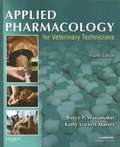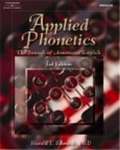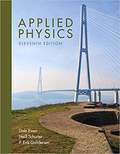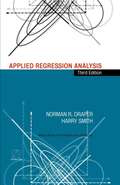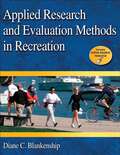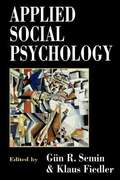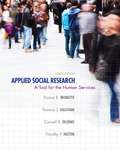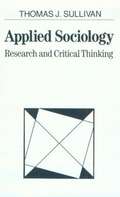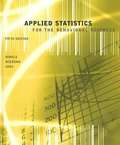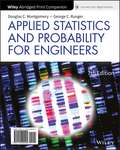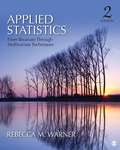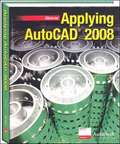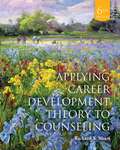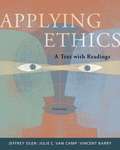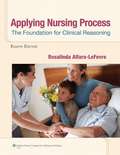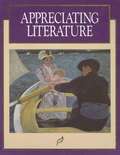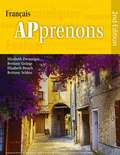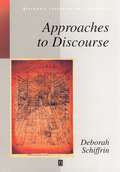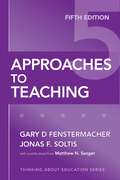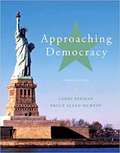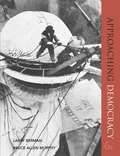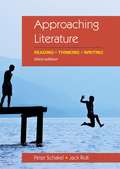- Table View
- List View
Applied Pharmacology for Veterinary Technicians (4th Edition)
by Boyce P. Wanamaker Kathy Lockett MasseyDesigned specifically for veterinary technicians, this essential resource offers detailed guidance on key topics such as managing medication inventory, dispensing veterinarian prescribed drugs, calculating drug dosages, administering medications to animals, and educating clients about drug side effects and precautions. Up-to-date drug information is presented in a consistent, easy-to-use format that includes pharmacokinetics, pharmacodynamics, clinical uses, dosage forms, and adverse side effects. Illustrated, step-by-step procedures demonstrate proper administration techniques for common drug forms. Learning Objectives at the beginning of each chapter help you focus your study efforts and check your progress as you work through the material. Chapter outlines provide at-a-glance overviews of the topics featured in each chapter, making it quick and easy to find information. Key Terms lists with definitions familiarize you with the terminology used in each chapter. Technicians Notes boxes throughout the book provide useful hints and important reminders to help you avoid common errors and increase your efficiency. Coverage of inventory control offers practical tips on performing this important task, including understanding the different vendor types, communicating with sales representatives, and using veterinary practice management computer software. Detailed summaries of important drug laws, such as the Animal Medicinal Drug Use Clarification Act and the Animal Drug Availability Act, introduce you to the legal and ethical aspects of veterinary pharmacology. The companion CD-ROM contains a handy drug dosage calculator and photographs of drug labels to familiarize you with the drug information youll encounter in practice. Proprietary drug names are listed along with generic names to help you learn to recognize drugs with generic options. Additional review questions in this edition help reinforce your understanding of key concepts. Answers are located in the back of the book so you can check the accuracy of your responses. The chapter on Drugs Used in Skin Disorders offers expanded coverage of the anatomy and physiology of the skin, as well as the latest drugs used to treat skin disorders.
Applied Phonetics: The Sounds of American English (3rd edition)
by Harold T. EdwardsFor the third edition Edwards (communicative disorders and sciences, Wichita State U., Wichita, Kansas) has expanded the sections on dynamics of speech, American English dialects, and speech mechanism. As in earlier editions, the volume teaches the student to transcribe in the first part. The second part, which can be used as a reference work, contains an exhaustive resource for each of the sounds of American English. Annotation (c)2003 Book News, Inc., Portland, OR (booknews.com)
Applied Physics
by P. Erik Gundersen Neill Schurter Dale EwenApplied Physics, 11th Edition presents clear, to-the-point, topical coverage of basic physics applied to industrial and technical fields. Throughout the text, emphasis is placed on teaching students to use a consistent problem-solving methodology. A wealth of real-world applications are presented, motivating students by teaching physics concepts in context. Updated with new color photos, clarifications, and enhancements, the Eleventh Edition also features sections on physics-related careers and new technologies to engage readers in the material.
Applied Radiological Anatomy
by Jeremiah C. Healy Paul Butler Adam W. M. MitchellThis expanded new, full colour edition of the classic Applied Radiological Anatomy is an exhaustive yet practical imaging resource of every organ system using all diagnostic modalities. Every illustration has been replaced, providing the most accurate and up-to-date radiographic scans available. Features of the second edition: * Completely new radiographic images throughout, giving the best possible anatomic examples currently available * Both normal anatomy and normal variants shown * Numerous colour line illustrations of key anatomy to aid interpretation of scans * Concise text and numerous bullet-lists enhance the images and enable quick assimilation of key anatomic features * Every imaging modality included Edited and written by a team of radiologists with a wealth of diagnostic experience and teaching expertise, and lavishly illustrated with over 1,000 completely new, state-of-the-art images, Applied Radiological Anatomy, second edition, is an essential purchase for radiologists at any stage of their career.
Applied Regression Analysis (Wiley Series in Probability and Statistics #326)
by Norman R. Draper Harry SmithAn outstanding introduction to the fundamentals of regression analysis-updated and expanded The methods of regression analysis are the most widely used statistical tools for discovering the relationships among variables. This classic text, with its emphasis on clear, thorough presentation of concepts and applications, offers a complete, easily accessible introduction to the fundamentals of regression analysis. Assuming only a basic knowledge of elementary statistics, Applied Regression Analysis, Third Edition focuses on the fitting and checking of both linear and nonlinear regression models, using small and large data sets, with pocket calculators or computers. This Third Edition features separate chapters on multicollinearity, generalized linear models, mixture ingredients, geometry of regression, robust regression, and resampling procedures. Extensive support materials include sets of carefully designed exercises with full or partial solutions and a series of true/false questions with answers. All data sets used in both the text and the exercises can be found on the companion disk at the back of the book. For analysts, researchers, and students in university, industrial, and government courses on regression, this text is an excellent introduction to the subject and an efficient means of learning how to use a valuable analytical tool. It will also prove an invaluable reference resource for applied scientists and statisticians.
Applied Research and Evaluation Methods in Recreation
by Diane C. BlankenshipThe importance of research and evaluation in the park and recreation industry is becoming increasingly evident as agencies are being asked to justify their existence to a variety of stakeholders. By properly evaluating programs, recreation professionals can better understand the impact of their programs and, with data in hand, justify future investments. Applied Research and Evaluation Methods in Recreation helps students build the competencies they need in order to meet professional standards. <p><p>Applied Research and Evaluation Methods in Recreation is the only text that integrates research, evaluation, and basic statistical analysis and links these concepts directly to the recreation field. Using a logical format and accessible language, the book provides students with the foundational knowledge they need in order to move through the research process. They’ll explore the various types of research commonly used in the field (including qualitative, quantitative, and action research) and then learn about the steps involved in designing a project, from developing the research problem, reviewing literature, and identifying variables and hypotheses to defining the population to study, developing the instrumentation plan, and choosing the appropriate data-collection tools. Then they’ll move on to evaluation concepts, including internal validity, data analysis, and reporting methods. <p><p>The author’s approach to the material makes this textbook truly unique. Each chapter builds on the previous one to clearly explain the steps of the research process and show how all of the concepts are interrelated. Students will learn not only why the steps and concepts are important but also how they relate specifically to the field. Each chapter closes with features that help students apply what they’ve learned: a case study, exercises, and For the Investigator, an ongoing research project that uses a hypothetical recreation survey to give students realistic practice in recreation research. The text contains many other features that will help students better understand and apply the concepts they’ve learned. Chapter-opening scenarios offer examples of the kinds of research that students might be expected to undertake. Objectives highlight the key points of each chapter, and a glossary offers easy access to definitions of unfamiliar terms. Professional Perspectives sidebars describe real research projects from current professionals with an explanation of the project’s importance to the organization. <p><p>Through the practical approach of Applied Research and Evaluation Methods in Recreation, students will gain the foundational knowledge they need in order too become confident in using their research and evaluation skills to meet the demands of their profession.
Applied Social Psychology
by Gun R. Semin Klaus FiedlerThis comprehensive textbook overviews the applications of social psychology to a wide range of problems and issues in contemporary society. With internationally respected contributors who survey the major developments in their fields, this practical guide incorporates advice, examples and reading lists.
Applied Social Research: A Tool for the Human Services
by Thomas J. Sullivan Duane R. Monette Cornell R. DejongYou may be wondering why you need to study research methods to prepare yourself for a career in human services. This accessible text will help you to better understand the connection between human service research and practice. APPLIED SOCIAL RESEARCH brings the subject to life and explores how recent innovations in technology are affecting research methods and results.
Applied Sociology: Research and Critical Thinking
by Thomas J. SullivanThis book is about applied sociology: the use of sociological and social science research to help us understand problems that people face and to help ease those problems through changes in social policy or other practices.
Applied Statistics For The Behavioral Sciences
by William Wiersma Stephen G. Jurs Dennis E. HinkleThis introductory text provides students with a conceptual understanding of basic statistical procedures, as well as the computational skills needed to complete them. The clear presentation, accessible language, and step-by-step instruction make it easy for students from a variety of social science disciplines to grasp the material. The scenarios presented in chapter exercises span the curriculum, from political science to marketing, so that students make a connection between their own area of interest and the study of statistics. Unique coverage focuses on concepts critical to understanding current statistical research such as power and sample size, multiple comparison tests, multiple regression, and analysis of covariance. Additional SPSS coverage throughout the text includes computer printouts and expanded discussion of their contents in interpreting the results of sample exercises.
Applied Statistics and Probability for Engineers
by Douglas C. Montgomery George C. RungerApplied Statistics and Probability for Engineers provides a practical approach to probability and statistical methods. Students learn how the material will be relevant in their careers by including a rich collection of examples and problem sets that reflect realistic applications and situations. This product focuses on real engineering applications and real engineering solutions while including material on the bootstrap, increased emphasis on the use of p-value, coverage of equivalence testing, and combining p-values. The base content, examples, exercises and answers presented in this product have been meticulously checked for accuracy.
Applied Statistics: From Bivariate Through Multivariate Techniques (2nd Edition)
by Rebecca M. WarnerApplied Statistics: From Bivariate Through Multivariate Techniques, Second Edition provides a clear introduction to widely used topics in bivariate and multivariate statistics, including multiple regression, discriminant analysis, MANOVA, factor analysis, and binary logistic regression. The approach is applied and does not require formal mathematics; equations are accompanied by verbal explanations. Students are asked to think about the meaning of equations. Each chapter presents a complete empirical research example to illustrate the application of a specific method. Although SPSS examples are used throughout the book, the conceptual material will be helpful for users of different programs. Each chapter has a glossary and comprehension questions.
Applying AutoCad 2008
by Terry T. WohlersApplying AutoCAD 2008introduces new features and enhancements to existing capabilities. What's New in 2008? * A new default workspace called 2DDrafting & Annotationhas been added. * The new 2D Drafting and Annotation workspace employs a new Dashboard containing panels and toolbars for drawing and dimensioning in two dimensions, while new panels and features improve the Dashboard for the 3D Modeling workspace. * New dimensioning capabilities are introduced, including a new Multileader tool and easy alignment and spacing control of dimension lines. * New commands and features to control drawing annotations are added to simplify and improve Multiline text, text styles, tables, and the creation of bill of materials.
Applying Career Development Theory to Counseling 6th Edition
by Richard S. SharfA must-read for counselors in training, Sharf's APPLYING CAREER DEVELOPMENT THEORY TO COUNSELING, 6th Edition, shows you how to apply the principles of career development to a variety of counseling settings. This book is clearly written, filled with useful case examples, and includes integrated diversity coverage to give you the advantage in your course and your career.
Applying Ethics: A Text With Readings
by Jeffrey Olen Julie C. Van Camp Vincent BarryDiscover the ethical implications and issues surrounding today's most compelling social dilemmas--from genetic engineering and cloning to terrorism and the use of torture--with APPLYING ETHICS: A TEXT WITH READINGS, 11th Edition. <p><p>Framed by the authors' helpful introductions and supported by a variety of readings and cases that reflect both sides of the topics being explored, this best-selling book offers a balanced introduction to ethics today.
Applying Ethics: A Text with Readings (9th edition)
by Jeffrey Olen Julie C. Van Camp Vincent BarryThis book introduces students to ethics via a well-proven formula of engaging commentary, seminal readings, and thought-provoking cases drawn from a wide range of contemporary social debates.
Applying Nursing Process: The Foundation for Clinical Reasoning
by Rosalinda Alfaro-LeFevreBecause principles of nursing process are the building blocks for all care models, the nursing process is the first model nurses need to learn to “think like a nurse.” This trusted resource provides the practical guidance needed to understand and apply each phase of the nursing process, with an increased emphasis on developing both critical thinking and clinical reasoning skills. With an easy-to-follow and engaging writing style, the author provides strategies, tools, and abundant examples to help nurses develop the skills they need to thrive in today’s complex health care setting.
Appreciating Literature: Signature Edition
by Editors at the McGraw-Hill-GlencoeThis text offers some great literature to think about and an organized way to do so, through skills like comparing characters, analyzing points of view, contrasting settings, inferring outcomes etc.
Apprenons: Francais
by Elizabeth Zwanziger Brittany Goings Elizabeth Rench Brittany Selden GriffinNIMAC-sourced textbook
Approaches to Discourse (Blackwell Textbooks in Linguistics)
by Deborah Schiffrin<p>This is a guide to the various frameworks, concepts, and methods available for the analysis of discourse within linguistics. It compares six dominant approaches to discourse analysis: speech act theory, pragmatics, ethnomethodology, interactional sociolinguistics, ethnography of communication, and variation theory. <p>The author not only considers each approach from several standpoints but she also illustrates them through extensive applications to a variety of concrete social and linguistic problems facing discourse analysts.</p>
Approaches to Teaching (5th edition)
by Jonas F. Soltis Gary D. Fenstermacher Matthew N. SangerThis popular text continues using the format of the three approaches--The Executive, The Facilitator, and The Liberationist. For the Fifth Edition, the authors add four new case studies: "Scripted Teaching," "Accountability and Merit," "What is the Value of Caring Relationships?" and "School Funding. " Using these and other realistic case studies, they explore the strengths and weaknesses of each approach so that teachers can critically assess their own philosophical positions on teaching. Teachers are urged to ask themselves such questions as: What is the main goal of teaching? What is the most important purpose of education? What do I expect my students to eventually become? Is the way I structure my teaching influenced by how I view my role and goals? This updated edition also adds a new section called "Topics and Resources" to encourage further inquiry into teaching
Approaching Democracy
by Bruce Allen Murphy Larry A. BermanUpdated in its 8th edition, Approaching Democracy addresses the evolving nature of the American experiment in democratic government. It teaches readers the theory and basics of American political science and the nation's political history. It provides the critical thinking skills needed to analyze these evolving relationships. Larry Berman and Bruce Allen Murphy are long-time teachers of the Introductory American Political Science course in both large and small public and private universities. Their goal was to write a book that offers a clear and relevant theme in an easily readable format.
Approaching Democracy (6th edition)
by Larry Berman Bruce Allen MurphyApproaching Democracy addresses the evolving nature of the American experiment in democratic government. It teaches students the theory and the basics of American political science, the political history of this nation, and provides the critical thinking skills needed to analyze these evolving relationships.
Approaching Literature: Reading + Thinking + Writing (Third Edition)
by Jack Ridl Peter SchakelThe central aim of this book is to foster habits and skills of critical thinking. The third edition makes the book even more inclusive and accessible than the first and second editions. A unique feature of this book is its appendix on reading critical essays, which provides practical instruction on how to approach and read the academic essay, a genre that in itself is unfamiliar to many students, and which students may be asked to use as sources in their own writing.
